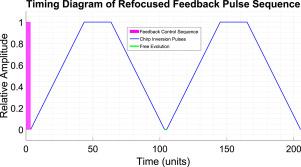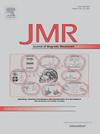重聚焦反馈对原子核自旋的宽带激发
IF 1.9
3区 化学
Q3 BIOCHEMICAL RESEARCH METHODS
引用次数: 0
摘要
精确控制系综中原子核自旋态的能力对于推进核磁共振波谱学至关重要。在本文中,我们提出了一种称为再聚焦反馈的技术,用于构建射频脉冲,使自旋态能够在化学位移的连续光谱中均匀跃迁。它被用来实现原子核系综的均匀宽带激发。基于策略选择的假设初始和最终条件设计射频脉冲,并根据反馈控制律迭代更新脉冲相位。然后将控制序列转换为实际系统中的应用。这种方法确保在化学位移的连续范围内均匀激发,同时从离散样品中数字化构建脉冲序列。本文章由计算机程序翻译,如有差异,请以英文原文为准。

Broadband excitation of nuclei spin by refocused feedback
The ability to precisely control the spin states of nuclei in an ensemble is critical for advancing NMR spectroscopy. In this paper, we present a technique referred to as Refocused Feedback to construct RF pulses that enable uniform transitions of spin states across the continuous spectrum of chemical shifts. It is used to achieve uniform broadband excitation of nuclei ensemble. The RF pulses are designed based on strategically selected hypothetical initial and final conditions, with the pulse phase iteratively updated according to the feedback control law. The control sequence is then transformed for applications in real systems. This approach ensures uniform excitation across the continuous range of chemical shifts while digitally constructing the pulse sequence from discrete samples.
求助全文
通过发布文献求助,成功后即可免费获取论文全文。
去求助
来源期刊
CiteScore
3.80
自引率
13.60%
发文量
150
审稿时长
69 days
期刊介绍:
The Journal of Magnetic Resonance presents original technical and scientific papers in all aspects of magnetic resonance, including nuclear magnetic resonance spectroscopy (NMR) of solids and liquids, electron spin/paramagnetic resonance (EPR), in vivo magnetic resonance imaging (MRI) and spectroscopy (MRS), nuclear quadrupole resonance (NQR) and magnetic resonance phenomena at nearly zero fields or in combination with optics. The Journal''s main aims include deepening the physical principles underlying all these spectroscopies, publishing significant theoretical and experimental results leading to spectral and spatial progress in these areas, and opening new MR-based applications in chemistry, biology and medicine. The Journal also seeks descriptions of novel apparatuses, new experimental protocols, and new procedures of data analysis and interpretation - including computational and quantum-mechanical methods - capable of advancing MR spectroscopy and imaging.

 求助内容:
求助内容: 应助结果提醒方式:
应助结果提醒方式:


